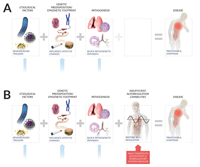Diagnostics and Therapeutic Strategy
Three principles guide the therapeutic approach in Bioregulatory Systems Medicine:
- The autoregulatory network is the primary therapeutic target instead of the trigger or the symptomatic effect of the trigger on the body.
- The status of the autoregulatory network and the disease progression determine the intervention.
- Interventions utilize multitarget medications that act in concordance with the multiple network interactions, feedback loops and biorhythms inherent in autoregulatory networks.
BrSM emphasizes improvement in patient outcomes through the support and stimulation of the autoregulatory system in the context of the disease trigger and individual predisposition. Symptoms should not be suppressed beyond easing patient discomfort, but should instead be used as a guide to evaluate the status of the autoregulatory system for clinical decision making. Accordingly, diagnostic measurements should be expanded beyond current markers (causative factors and symptoms) to include assessment of autoregulatory networks and blocks to autoregulation.
Therapeutic decisions in BrSM should be made based on the capacity of the affected autoregulatory network in relation to the causative stressor. This type of clinical model is hypothesized as better suited for accurate prediction of disease outcomes, intervention, follow-up, and disease prevention as part of an individualized treatment approach. Bioregulatory interventions can range from supporting autoregulatory capacity to stimulating the restoration of autoregulatory capabilities and clearing blocks to autoregulation. Medications with bioregulatory properties should be a temporary intervention that leaves the system in an optimal state.

Novel considerations of factors affecting disease.
Current medical paradigms (A) typically consider etiological factors, genetic predisposition and molecular pathways recruited in pathogenesis as key causative agents that lead to disease. Bioregulatory Systems Medicine (B) also considers the compromised or insufficient patient autoregulatory capacity to restore homeostasis as a key factor that influences individual disease incidence and manifestation. Restoration of patient autoregulatory capacity is therefore a primary therapeutic objective in Bioregulatory Systems Medicine, in addition to removal of triggers, lifestyle changes, and inhibition of pathogenetic pathways when appropriate.
